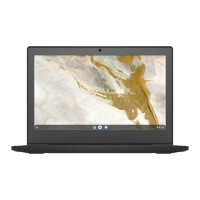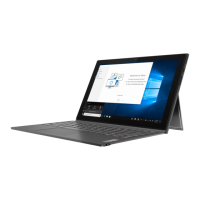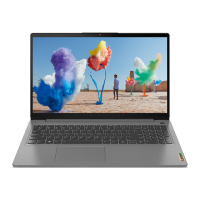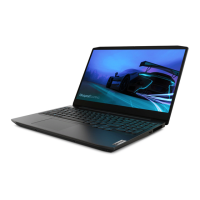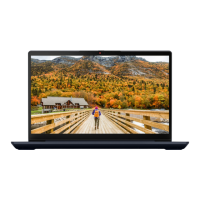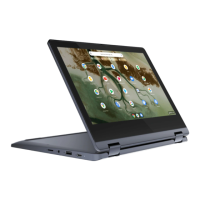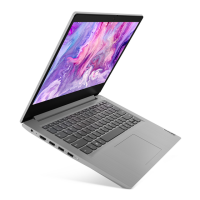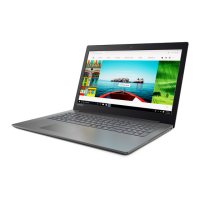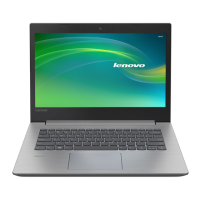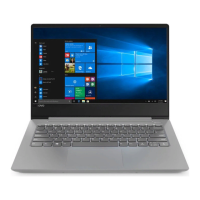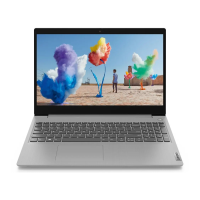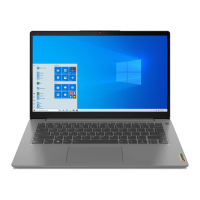
Do you have a question about the Lenovo IdeaPad 3i Series and is the answer not in the manual?
| Processor | Intel Core i3/i5/i7 |
|---|---|
| Display | HD (1366x768) or FHD (1920x1080) |
| Operating System | Windows 11 Home |
| Wireless | Wi-Fi 6 or Wi-Fi 5 (802.11ax or 802.11ac) |
| Bluetooth | Bluetooth 5.0 |
| Ports | HDMI |
| Webcam | 720p with privacy shutter |
| Graphics | NVIDIA GeForce MX series discrete graphics |
Details on front-facing components like microphones, camera, and screen.
Overview of base features for 14-inch models: power button, keyboard, touchpad.
Details on base features for 15/17-inch models: power button, numeric keypad, keyboard.
Description of connectors and ports on the left side of the computer.
Description of ports and buttons on the right side, including power and Novo button.
Details on the bottom of the computer, primarily the speakers.
Technical specifications for dimensions, power, memory, storage, screen, and keyboard.
Summary of all connectors, slots, security, and wireless features.
Information on data transfer rates for different USB device types.
Guidelines for maximum altitude and operating temperature/humidity.
Guide to setting up local and Microsoft accounts for Windows 10.
Instructions on switching between local and Microsoft accounts in Windows 10.
Steps to add additional user accounts to your Windows PC.
Explanation of key elements on the Windows 10 desktop interface.
Methods to open Control Panel and applications using Start menu or search.
Information on automatic and manual Windows updates and security.
Overview of Lenovo's software for system information, updates, and diagnostics.
Instructions for connecting your computer to a wired network via Ethernet.
Steps to connect your computer to wireless Wi-Fi networks.
How to remove saved Wi-Fi networks from your computer.
How to turn airplane mode on and off for wireless communication.
Accessing system utilities via the Novo button before OS startup.
Explanation of special function keys and their usage.
How to configure hotkey behavior via UEFI/BIOS settings.
Instructions on using the dedicated numeric keypad and Num Lock.
Guidance on managing power settings for performance and efficiency.
How to check battery status, charge the battery, and understand charging behavior.
Customizing the action performed when the power button is pressed.
Explanation of power plans and how to create or modify them.
How to switch between different performance modes using Fn+Q.
Introduction to the UEFI/BIOS setup utility and its purpose.
How to modify the boot order in UEFI/BIOS settings.
How to configure hotkey behavior via UEFI/BIOS settings.
How to manage always-on USB or other always-on functions in BIOS.
Setting and managing administrator, user, and hard disk passwords in BIOS.
Procedure for setting the BIOS administrator password.
How to modify or delete the BIOS administrator password.
Steps to set a BIOS user password for limited access.
Configuring the computer to require a password at startup.
How to set a password to protect the hard disk drive.
Procedure to modify or remove hard disk passwords.
Overview of Windows 10 recovery options for system issues.
Using System Restore to revert the computer to a previous state.
Manual steps to create a system restore point.
How to use a restore point to fix Windows problems.
Steps to reset the Windows 10 operating system to default settings.
Guide to creating a USB recovery drive for Windows.
Instructions for restoring or resetting Windows using a recovery drive.
Common questions and answers regarding computer operation and troubleshooting.
Information on accessing Lenovo support, drivers, and documentation.
Explanation of Customer Replaceable Units (CRUs) and types.
How to contact Lenovo Customer Support for assistance and warranty services.
Information to gather before calling Lenovo support for faster service.
Details on warranty services offered and excluded by Lenovo.
Information on acquiring extended warranty or other services from Lenovo.
Overview of Lenovo's commitment to accessibility and resources.
List of useful keyboard shortcuts for enhancing computer usability.
How to use Windows Ease of Access Center for system configuration.
Customizing keyboard and mouse settings for better usability.
Using voice commands to control the computer and its functions.
Information on screen reader software for visually impaired users.
Adjusting screen resolution and item size for readability.
Guidance on display, head, chair, arm, leg posture, and travel tips.
Tips for vision comfort, including night light and color temperature adjustments.
Cautionary advice on avoiding prolonged contact with hot computer surfaces.
FCC compliance statements for Class B digital devices.
Where to find FCC ID and IC ID information on the computer.
Korean compliance statements for wireless frequency usage and SAR.
General notices, disclaimers, and warranty information from Lenovo.
Disclaimer regarding potential mismatches between manual descriptions and actual hardware.
Statements about product use in life support or medical applications.
Disclaimer on performance data obtained in controlled environments.
List of trademarks associated with Lenovo and Microsoft products.
